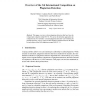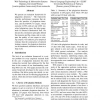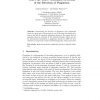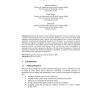CLEF
2011
Springer
12 years 11 months ago
2011
Springer
Abstract This paper overviews eleven plagiarism detectors that have been de
COLING
2010
13 years 6 months ago
2010
We present an evaluation framework for plagiarism detection.1 The framework provides performance measures that address the specifics of plagiarism detection, and the PAN-PC-10 cor...
COLING
2010
13 years 6 months ago
2010
Plagiarism is the use of the language and thoughts of another work and the representation of them as one's own original work. Various levels of plagiarism exist in many domai...
COLING
2010
13 years 6 months ago
2010
Plagiarism, the unacknowledged reuse of text, does not end at language boundaries. Cross-language plagiarism occurs if a text is translated from a fragment written in a different ...
CICLING
2010
Springer
13 years 6 months ago
2010
Springer
Determining the direction of plagiarism (who plagiarized whom in a given pair of documents) is one of the most interesting problems in the field of automatic plagiarism detection. ...
HT
2010
ACM
13 years 9 months ago
2010
ACM
This paper describes a new approach towards detecting plagiarism and scientific documents that have been read but not cited. In contrast to existing approaches, which analyze docu...
MICAI
2010
Springer
13 years 9 months ago
2010
Springer
Traditionally, External Plagiarism Detection has been carried out by determining and measuring the similar sections between a given pair of documents, known as source and suspiciou...
JUCS
2006
13 years 11 months ago
2006
: Plagiarism in the sense of "theft of intellectual property" has been around for as long as humans have produced work of art and research. However, easy access to the We...
IIE
2006
13 years 11 months ago
2006
Plagiarism in universities has always been a difficult problem to overcome. Various tools have been developed over the past few years to help teachers detect plagiarism in students...
CORR
2010
Springer
13 years 12 months ago
2010
Springer
Plagiarism detection is a growing need among educational institutions and solutions for different purposes exist. An important field in this direction is detecting cases of source...




